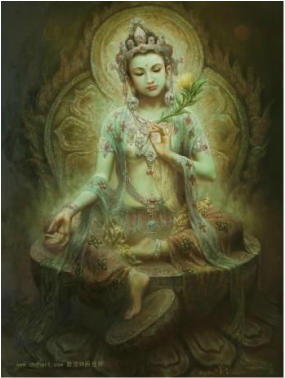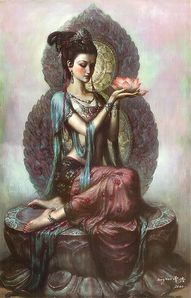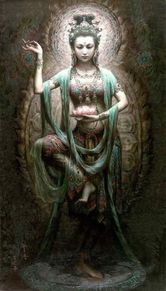|
Tibetan Buddhism is an intersting mix of the teachings of Mahayana Buddhism, Tibetan Bon religion, and the Hindu Tantric buddhism with its diverse rituals and magic. Out of the two main buddhist schools, Theravada (“The Teaching of the Elders“) and Mahayana („The Great Vehicle“), the latter has been more innovative, and more popular among ordinary people. One of the differences of the Theravada and Mahayana school of thought (see Comparative Study of Theravada and Mahayana Buddhism) is the interpretation of the bodhisattva concept. The Theravada followers see bodhisattva as someone focused on their own personal liberation. The Mahayana buddhists, on the other hand, strive towards the ideal of a bodhisattva who delays their enlightenment to help others on their spiritual path. As the result of these different influences, the Tibetan Buddhism has a rich tradition of spiritual methods (mantras, rituals, mandala creation, ceremonies, etc.) as well as many mystical beings, deities, and bodhisattvas. The most popular female deity in Tibet (and Tibetan communities in exile in Northern India) is the bodhisattva Tara. Regardless of wether she is considered a deity, Goddess or a bodhisattva, Tara is also much loved in Mongolia, Nepal, Bhutan, and is worshipped in most Buddhist communities all over the world. The bodhisattva Tara (in Tibetan: Dolma) symbolizes universal compassion and loving-kindness. Tara’s popularity in Tibet is often attributed to Indian teacher named Atisha who travelled to Tibet during 11th century. According to a legend, the bodhisattva Avalokiteshvara had wept for all suffering people, and out of his tears grew a beautiful lotus. From this lotus flower, Tara was born with a mission to help and save all beings. The elements and hand gestures of Tara symbolize protection, fearlessness, wisdom , blessings, virtue, and quick compassionate action. The Tibetan Tara has also been compared to the Christian Virgin Mary as they both represent love and compassion. More importantly, the bodhisattva Tara has even been considered as a feminist, since she has positively affected the inclusion of women in male dominated buddhism. "There is a true feminist movement in Buddhism that relates to the goddess Tara. Following her cultivation of bodhicitta, the bodhisattva's motivation, she looked upon the situation of those striving towards full awakening and she felt that there were too few people who attained Buddhahood as women. So she vowed, 'I have developed bodhicitta as a woman. For all my lifetimes along the path I vow to be born as a woman, and in my final lifetime when I attain Buddhahood, then, too, I will be a woman.'" (Dalai Lama, 1989) Tara Mantra is Om tare tuttare ture svaha/soha, and the Tibetans believe that reciting this mantra has the power to increase our ability to receive and give loving energy, eliminate fear, diseases, bring peace, fulfil wishes, and overcome obstacles.
0 Comments
Leave a Reply. |



 RSS Feed
RSS Feed
